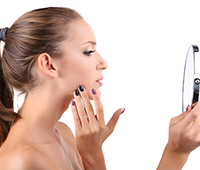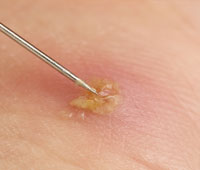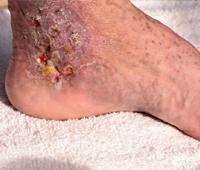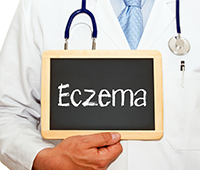WHAT IS Corns and calluses
- Definition
- Causes
- Symptoms
- Diagnosis
- Ayurvedic Tips
- FAQS
- References
Definition
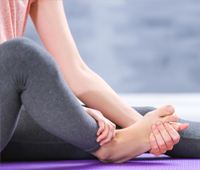
Corns and calluses are thick, hardened layers of skin that grow when the skin tries to protect itself against friction and pressure. They are generally seen on the feet and toes, or hands and fingers.[i]
Ayurveda describes corns as Kadara (one of the Kshudra rogas), a horny induration of the skin with a hard centre formed because of excessive pressure, mainly affecting the toes and feet.[ii]
Disclaimer: The information on this page is not intended to be a substitute for professional medical advice. Do not use this information to diagnose or ayurvedic treatment of dermatology and/or corns and calluses without consulting the doctor. Consult your physician before beginning an exercise regime. "While we have products /ayurvedic medicines for dermatology and/or corns and calluses, you must consult an authorized physician before taking any of the products. For more information on products, visit www.dabur.com or call 1800-103-1644"
Causes
Causes OF Corns and calluses
Corns and calluses generally develop due to pressure and friction from repetitive actions, namely:[i]
- Wearing ill-fitting shoes
- Avoiding socks
- Playing instruments or using hand tools
Kadara may grow due to imbalance of Vata with Kapha dosha. Vata and Kapha dosha are considered as the important factors resulting in Shotha (inflammation) and Shoola (pain).[ii]
Diabetes or another condition that leads to poor blood circulation to the feet may increase the risk of complications from corns and calluses.1
Disclaimer: The information on this page is not intended to be a substitute for professional medical advice. Do not use this information to diagnose or ayurvedic treatment of dermatology and/or corns and calluses without consulting the doctor. Consult your physician before beginning an exercise regime. "While we have products /ayurvedic medicines for dermatology and/or corns and calluses, you must consult an authorized physician before taking any of the products. For more information on products, visit www.dabur.com or call 1800-103-1644"
Symptoms
Symptoms OF Corns and calluses
Corns are smaller than calluses, have a hard middle part enclosed by inflamed skin, and can be quite painful. They are generally found in regions of the feet that don’t endure weight.
Calluses are hardly painful, vary in size and shape, and generally develop on the soles of the feet, especially under the heels or balls, on the palms or the knees.
Signs and symptoms of corns and calluses include:
- A thick, rough area of skin
- A hardened, raised bump
- Tenderness or pain under the skin
- Flaky, dry or waxy skin
Disclaimer: The information on this page is not intended to be a substitute for professional medical advice. Do not use this information to diagnose or ayurvedic treatment of dermatology and/or corns and calluses without consulting the doctor. Consult your physician before beginning an exercise regime. "While we have products /ayurvedic medicines for dermatology and/or corns and calluses, you must consult an authorized physician before taking any of the products. For more information on products, visit www.dabur.com or call 1800-103-1644"
Diagnosis
Diagnosis OF Corns and calluses
Tests and procedures used to diagnose corns and calluses include:
- A physical examination of the feet to rule out other causes of thickened skin, such as warts and cysts.
- An X-ray of the hand or foot to determine if a physical anomaly is causing the corn or callus.
Disclaimer: The information on this page is not intended to be a substitute for professional medical advice. Do not use this information to diagnose or ayurvedic treatment of dermatology and/or corns and calluses without consulting the doctor. Consult your physician before beginning an exercise regime. "While we have products /ayurvedic medicines for dermatology and/or corns and calluses, you must consult an authorized physician before taking any of the products. For more information on products, visit www.dabur.com or call 1800-103-1644"
Ayurvedic Tips
Ayurvedic Tips Corns and calluses
Tests and procedures used to diagnose corns and calluses include:
- A physical examination of the feet to rule out other causes of thickened skin, such as warts and cysts.
- An X-ray of the hand or foot to determine if a physical anomaly is causing the corn or callus.
Diet Recommendations (Aahar)
- Cooked foods rather than raw foods and salads should be consumed.
- Consumption of light, dry, cold foods and pungent, bitter and astringent tastes should be reduced.
- Hot, milky, creamy cereals (wheat, oatmeal or rice), soups and stews are all good for pacifying Vata.
- Herbal teas (camomile, fennel, basil) are beneficial for Vata energy slumps.
- Stimulants such as coffee and alcohol should be avoided.
- Warm/hot water should be consumed throughout the day to flush out impurities and balance Vata.
Lifestyle changes (Vihar)
- Vata benefits from slow, grounding Yoga positions that connect with the breath.
- Halasana is another great Vata reducing Yoga
- Regular Yogic practice increases the awareness of mind and body, essential to maintain the exercise and food habit in diabetic condition.
Disclaimer: The information on this page is not intended to be a substitute for professional medical advice. Do not use this information to diagnose or ayurvedic treatment of dermatology and/or corns and calluses without consulting the doctor. Consult your physician before beginning an exercise regime. "While we have products /ayurvedic medicines for dermatology and/or corns and calluses, you must consult an authorized physician before taking any of the products. For more information on products, visit www.dabur.com or call 1800-103-1644"
FAQS
FAQS
1.What diet changes according to Ayurveda, can I do to reduce acne on my skin?
Ayurveda suggests following diet changes for healthy, acne free skin:
- Include food items with bitter taste like pointed gourd vegetables, Giloya, Methi etc.
- Include adequate fresh green and leafy vegetables in the diet
- Ensure sufficient water intake (especially Luke warm water)
- Avoid hot, spicy, oily, fried and pungent food, junk food, fast food, and outside food
- Avoid sour foods
- Avoid food that is incompatible to each other such as Milk with salty foods, Fish
- Avoid constipation, stress and anxiety
2.How is acne treated in Ayurveda?
Acne management by Ayurvedic principles requires a holistic approach. Diet (ahar), lifestyle (vihar) and medication (aushadhi) are two important aspects of management. Apart from that there are other external therapies (Shodham) recommended such as:
- Vaman – inducing controlled vomiting to eliminate toxins
- Virechan – controlled purgation for specific time to detox
- Nasya – procedure wherein herbalized oils and liquid medicines are administered through the nostrils which improves oxygen supply to the body and cleanses the system
- Rakta Mokshna- also known as blood-letting, this involves, extracting a small amount of blood from a vein which relieves the tension created by the toxins. Leech therapy is generally employed for this purpose.
3.I keep getting fungal infections regularly. What are the reasons?
Fungal Infection is called dadru in Ayurveda. It is limited to the dead layers of skin but is usually encouraged by a damp and warm weather. The infection can be transmitted to humans through another infected person, through soil, damp shower floors or through pet animals.
According to Ayurveda, cause of Dadru is four pronged
- Virudhashan – Intake of wrong food combinations like sour curd and milk together, sea food and milk together makes skin prone for infections.
- Vishamasan – Heavy food intake or eating speedily also causes fungal diseases because of kapha and pitta dushti
- Adhyashan – Excessive food intake also contribute to the same
- Kledakar Ahar – Food habits increasing kapha and pitta like – oily food, junk food and fermented foods are also responsible
4.How can I identify if I have fungal infection/dadru?
Fungal infection symptoms vary from person to person. Itching, rash and nail discoloration are the most common symptoms of tinea infection. Symptoms also depend on the affected area of the body:
- Ringworm is a red skin rash that forms a ring around normal-looking skin. A worm doesn't cause it
- Scalp ringworm (tinea capitis) causes itchy, red patches on your head. It can leave bald spots. It usually affects children
- Athlete's foot causes itching, burning and cracked skin between your toes
- Jock itch causes an itchy, burning rash in your groin area
5.What is Ayurveda management for getting rid of lice?
Following is Ayurvedic way of getting rid of lice -
- Apply the leaf juice of Indian hemp (Charas/Ganjaayi) or the paste of the leaves to the scalp and hair
- Application of the paste of bitter almonds is also good if you are unable to procure the Indian hemp
- The ointment made of the powder of the bark of Celastrus paniculatus (Malakanguni) with mustard oil is another good remedy for head lice.
- Apply the paste made of the finely powdered seeds of custard apple (Seetaa-phal) with water at bedtime and cover the head with a cloth. The paste should not come in contact with your eyes.
- Soak the hair well with tobacco paste and cover with a cloth for two to three hours. Then rinse thoroughly with the emulsion of soap-nut (rita)
- Alum (Phitkari) is the non-herbal Ayurvedic remedy for lice. Dissolve three grams of alum in half a liter of water. Apply this solution regularly on the head
6.What is impetigo?
Impetigo is a contagious bacterial skin infection most common among preschool children. People who play close contact sports, such as wrestling are also susceptible, regardless of age. There are three types of impetigo:
- Contagious impetigo: This is the most common form of impetigo. It most often begins as a red sore near the nose or mouth which soon breaks, leaking pusor fluid, and forms a honey-colored scab, followed by a red mark which heals without leaving a scar.
- Bullous impetigo: Bullous impetigo, mainly seen in children younger than 2 years, involves painless, fluid-filled blisters, mostly on the arms, legs, and trunk, surrounded by red and itchy (but not sore) skin. The blisters may be large or small. After they break, they form yellow scabs.
- Ecthyma: In this form of impetigo, painful fluid- or pus-filled sores with redness of skin, usually on the arms and legs, become ulcers that penetrate deeper into the dermis. After they break open, they form hard, thick, gray-yellow scabs, which sometimes leave scars. Ecthymamay be accompanied by swollen lymph nodes in the affected area.
7.What can I do to prevent impetigo?
Some Ayurveda tips for preventing impetigo are as follows:
- Wash the affected area with neem decoction, which has natural antiseptic properties.
- Use only herbal soap which also protects the further attack of bacteria.
- Ayurveda have many herbs which acts as natural Antibiotics and antiseptic. They are in the form of tablets, powder and syrup based. They also have anti-inflammatory effect.
- Apply Ayurvedic Herbal antiseptic creams at the affected area till the lesions goes.
- When the skin becomes normal , apply herbal oils which nourishes the skin and helps to protect from the bacterial attack
8.My skin is dry. Are there any dietary tips that will help me manage my skin?
Following are few dietary tips to manage dry skin.
- Consume a balanced diet which includes foods from all groups like vegetables, fruits, carbohydrates, cereals, milk and milk products.
- Include yellow and orange colored vegetables like carrot which have rich anti-oxidants.
- Avoid junk food like chips, deep fried food etc
- Avoid stale, over fried, dry food.
- Always consume fresh warm food with little fat like ghee or olive oil
- Include sour and salty food in diet
- Sweet juicy fruits are recommended.
- Drink 7-9 glasses of warm water every day. (Do not drink cold water as it increases vata)
9.What are the tips to prevent my skin from becoming dry?
Certain simple lifestyle changes can help prevent you from developing dry skin
- Do not use hot water to cleanse dry skin.
- Use a soft cotton cloth and pat dry your skin. Do not rub the skin with harsh, rough textured towels.
- Instead of washing with water use a clean sprayer to moisten your skin. Use mineral water instead of tap water for spray.
- Lightly pat dry the skin.
- Avoid using harsh soaps and face washes as they remove natural oil that protects your skin.
- Pamper your skin by massaging with moisturizer. Moisturizer increases the moisture of upper layer of skin and makes it soft and smooth.
- Regularly massage your body with herbal oil. Herbal oil softens and sooth the dry skin and help to trap the moisture between skin pores.
- Apply a thin layer of coconut oil before finishing the bath and pat dry the skin
It is also important to choose the right kind of moisturizer for your skin type. Lotions that contain grape seed oil and antioxidants can help trap water in the skin. If your skin is extremely dry, look for a petrolatum-based product
10.What is measles?
Measles is a highly contagious infection caused by the measles virus. Though it is a common childhood infection, it may also affect adults. Initial signs and symptoms typically include fever, often greater than 104.0 °F, cough, runny nose, and inflamed eyes. Two or three days after the start of symptoms, small white spots may form inside the mouth. A red, flat rash which usually starts on the face and then spreads to the rest of the body typically begins three to five days after the start of symptoms. Symptoms usually develop 10–12 days after exposure to an infected person and last 7–10 days.
Nine out of ten people who are not vaccinated and share living space with an infected person will catch it. People are infectious to others from four days before to four days after the start of the rash. People usually do not get the disease more than once. Testing for the virus in suspected cases is important for public health efforts. Measles is commonly known as Romantika in Ayurveda
11.I have grade 2 Acne. What are the foods that I should be consuming?
- Include food items with bitter taste like pointed gourd vegetables, Giloya, Methi , Parwal, brinjal etc.
- Include adequate fresh green and leafy vegetables in the diet
- Ensure sufficient water intake (especially Luke warm water)
- Avoid hot, spicy, oily, fried and pungent food, junk food, fast food, and outside food
- Avoid sour foods
- Avoid food that is incompatible to each other such as Milk with Fish
- Avoid day sleep
12.I am easily prone to acquire ringworm infection. What measures should I take to prevent it?
The management of skin diseases including ringworm begins with purification processes like vaman karma (therapeutic emesis) which is especially indicated in Skin disorders. Apart from this virechan (therapeutic purgation), raktamokshana (therapeutic bloodletting) Ahar (Diet) and Vihar (lifestyle) regimens have to be followed as per the following guidelines. Medications (aushadhi) include topical as well as internal administration.
Ahar Recommendations:
- Have light, fresh and wholesome foods mixed with ghee
- Make sure to include bitter and leafy vegetables in your diet-methi, parval, brinjal
- Avoid incompatible foods- eating foods in combination - sour foods, milk, yogurt, meat, cane, sugar and sesame seeds
- Avoiding long term use of honey, fish, and radish may be beneficial
Vihar recommendations:
- Avoids foods of extreme temperature – too hot or too cold
- Avoid excessive exercise, and heat-exposure before digesting meals
- Do not suppress the urge for emesis
- Have bath with luke warm water.Use of cold water just in states of fear, grief, and exhaustion may further aggravate doshas and worsen dadru.
- Internal purification through Shankhaprakshalana (Gastrointestinal lavage) can help emove acidic wastes which may predispose to skin and fungal infections. Shankhaprakshalana is a master purifying process to clean the intestinal tract by removing the impurities with the use of salty water, dietary regulation and yogasanas - the six asanas (Tadasana,Triyak tadasana, Kati Chakrasana,Tiryaka Bhujangasana, Udarakarshan, Kakhpadasana) 6 times each for two rounds. This should not be practiced without the help of a yoga guru.
13.What kinds of food must be avoided in eczematic condition?
Hot and spicy foods, Excess fermented foods, Excess salt, Red or sweet wine and alcohol, Sour fruits, Deep fried foods, Ice cream and cold drinks, Coffee, Strong tea, Over consumption of nuts.
14.Is oral herpes contagious?
Herpes simplex viruses spread from person to person through close contact (.contagious disease) and one can get a herpes simplex virus from touching a herpes sore. A person with HSV-1 (herpes simplex type 1) can pass it to someone else by – kissing, touching the person’s skin, such as pinching a child’s cheek or by sharing objects such as silverware, lip balm, or a razor.
15.What causes Psoriasis?
There is no well-established clear cause of psoriasis. Researchers believe that it can be passed on genetically. It can also develop when a person’s immune system gives wrong signal that tell skin cells to grow too quickly. New skin cells form rapidly in days and the body does not shed these excess skin cells. The skin cells pile up on the surface of the skin, causing patches of psoriasis to appear. Stress, diet, cold dry weather, streptococcal infection and certain medications like lithium, trigger the condition further. In Sidhma Kushta the predominant doshas vitiated are kapha and pitta. In Ekta Kushta it is Kapha and vata. Due to faulty eating habits, poor lifestyle and karma, toxins get accumulated in the skin layers which gets exhibited as psoriasis.
16.Can you recommend few yoga poses beneficial in Psoriasis?
- Pranayama: Bhastrika pranayama, Bahya pranayama, Anelom Vilom (AV) pranayama, Agnisaar pranayama, Bhramari pranayama, Udgeet pranayama, Kapalbhati and Nadi Shodhi should be practiced for 15 minutes. Kapalbhati pranayama removes toxins from the respiratory system and Nadi Shodhi pranayama increases the oxygen levels in the lungs tremendously which helps in cleaning the nerves. Both these pranayamas also reduce stress.
- Asana: Postures that improve the endrocrine system and massage thyroid and parathyroid glands. Such asanas include Sarvangasana, Halasana, Tiger breathing (cat & cow), Janusirsasana, and the Therapy series (or Tibetan Rites). These should be practiced with deep breathing, holding postures for 3-5 breaths and up to 21 rounds for the Tibetan Rites.
- Meditation: Of all the remedies provided by Yoga Therapy, there is nothing more powerful than meditation to reduce stress. Stress is one of the critical factors that aggravate psoriasis.
17.I suffer from Psoriasis. What kinds of Ayurvedic medication is recommended to cure it?
Removal of toxins are beneficial. As per Ayurveda, Bio purificatory measures like vamana (therapeutic emesis) virechana (therapeutic purgation) & vasti karma (medicated enemas) are beneficial in Psoriasis.
18.Can you suggest Ayurvedic treatment for leucoderma?
Ayurvedic management of vitiligo begins with a purification process. Purification methods such as snehana (oleation therapies), svedana (fomentation or heat therapy), vaman (therapeutic emesis), virechana (therapeutic purgation) and raktamokshana (therapeutic bloodletting) are employed to “loosen and liquefy Ama (toxins/ undigestive material)” and excess dosha from the various sites of accumulation in the tissue. Exposure to sun rays is also recommended. Apart from the various aushadhis (medicines), ahar (diet) and vihar (lifestyle) regimens are also very important which are listed below:
Ahar Recommendations:
- Have light meals
- Include old rice, wheat and green gram in your diet
- Include gourd family vegetables like bitter-gourd and ridged gourd in your diet
- Avoid tea, coffee, alcoholic beverages
- Highly/ strongly- flavoured dishes and condiments also to be avoided
- Limit intake of sugar, processed/white flour products, denatured cereals like polished rice and pearled barley
- Avoid vegetable roots and tubers like potato, carrot, colocasia and black gram
- Avoid consumption of tinned or bottled foods and aquatic animals
Vihar recommendations:
- Following Sadvrtta (behavioral and social codes of conduct), bio-purification therapes (panchakarma) and personal hygiene are recommended.
- Kapalbhati is helpful in the treatment of vitiligo. Because of inhalation and exhalation kapalbhati provides aeration to blood and purifies blood circulation.
- Tadasana allows tofocus on deep, rhythmic breathing - drawing oxygen into and out of the body releases harmful toxins and keeps vital systems running optimally.
- Uttanasana - Because forward-bending poses fight against gravity by turning the head toward the ground instead of toward the sky. Blood flows into the face faster, bringing with it oxygen and other helpful nutrients that fight free radicals and encourages skin cell renewal.
- Utkatasana make the heart beat faster, increasing the circulation of blood flow throughout the body and prompting the skin to sweat out impurities.
- Viparita Karani - Inversions such as Head-stand and Shoulder-stand increase blood flow to the face amd help eliminating toxins
- Daivavyaprashya chikitsa - Vrata-pooja-patha-dana (fasting, worship, enchanting the sacred hymens, donation, etc.)
- Visit to pilgrimage places
19.What are the Ayurvedic remedies for acne?
Acne management by Ayurvedic principles requires a holistic approach. Diet (ahar), lifestyle (vihar) and medication (aushadhi) are two important aspects of management. Apart from that there are other external therapies (Shodham) recommended such as:
- Vaman – inducing controlled vomiting to eliminate toxins- good for Kapha dosha
- Virechan – controlled purgation for specific time to detox- good for vitiated Rakta
- Nasya – procedure wherein herbalized oils and liquid medicines are administered through the nostrils which remove toxins, improves circulation and cleanses the system
- Rakta Mokshna- also known as blood-letting, this involves, extracting a small amount of blood from a vein which relieves the tension created by the toxins. Leech therapy is employed for the purpose.
Aahar recommendations
- Include food items with bitter taste like pointed gourd vegetables, Giloya, Methi , Parwal, brinjal etc.
- Include adequate fresh green and leafy vegetables in the diet
- Ensure sufficient water intake (especially Luke warm water)
- Avoid hot, spicy, oily, fried and pungent food, junk food, fast food, and outside food
- Avoid sour foods
- Avoid food that is incompatible to each other such as Milk with Fish
Vihar recommendations
- Keeping the face clean-wash with water and mild soap
- Meditation is recommended to reduce stress
- Prithvi Mudra – Joining tip of thumb and ring finger has proven to be beneficial
- Avoid exertion immediately after a meal
- Sleep well during the night and avoid sleeping during the day
- Reducing use of cosmetics
20.What causes eczema?
As per Ayurvedic classics, Raktadushti (vitiation of blood) is one of the prime causes of skin diseases. Same is the case with Vicharchika, where it is considered to be a Rakta Pradosha Vikara (diseases caused due to the vitiation of blood) having involvement of three Dosha with specific dominance of Kapha.
Disclaimer: The information on this page is not intended to be a substitute for professional medical advice. Do not use this information to diagnose or ayurvedic treatment of dermatology and/or corns and calluses without consulting the doctor. Consult your physician before beginning an exercise regime. "While we have products /ayurvedic medicines for dermatology and/or corns and calluses, you must consult an authorized physician before taking any of the products. For more information on products, visit www.dabur.com or call 1800-103-1644"
References
References
- Vijayashankar BV et al. A prospective study of prathisaraneeya apamarga kshara in comparison with prathisaraneeya palasha kshara in patients with charmakeela (warts) and kadara (corns). J Phyto. 2014 Sep-Oct; 3(5): 330-336.
- Gupta S et al. Agnikarma- A trenchant technique for catholicon of kadara W.S.R TO Corn. Ayushdhara. 2016 Jan-Feb; 3(1): 486-490.
- Kumar A et al. A Case Study on Kadara By Agnikarma With The Use Of Panchadhatu Shalaka. IAMJ. 2016 Feb; 4(2): 170-174.
- Cavanagh D and Willis C. Essential Ayurveda: The Practical Guide to Healthy Living.
- Indian Traditional Medicinal Systems, Herbal Medicine, and Diabetes. In. Diabetes Mellitus in 21st Century. Sen S, Chakraborty R, and De B (eds.). 2016. Springer Singapore: pp 125-151.
Disclaimer: The information on this page is not intended to be a substitute for professional medical advice. Do not use this information to diagnose or ayurvedic treatment of dermatology and/or corns and calluses without consulting the doctor. Consult your physician before beginning an exercise regime. "While we have products /ayurvedic medicines for dermatology and/or corns and calluses, you must consult an authorized physician before taking any of the products. For more information on products, visit www.dabur.com or call 1800-103-1644"
Know more on Dermatology
